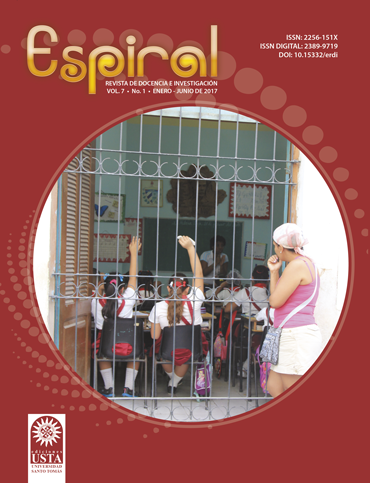Efectos de la teoría sociocultural de Vygotsky en el aprendizaje de una segunda lengua y aporte lingüístico
Resumen
Objetivo. El presente artículo de reflexión se deriva del Diplomado en Actualización de Prácticas de Enseñanza del Inglés con énfasis en el Diseño de Experiencias de Aprendizaje, el cual tuvo lugar en la Universidad Industrial de Santander, Colombia. Tiene como objetivo suscitar una reflexión acerca del papel fundamental del input comprensible y las interacciones sociales entre los estudiantes de una segunda lengua, docentes y compañeros en un espacio de aprendizaje significativo. Adicionalmente, un modelo de enseñanza revolucionario llamado SIOP para estudiantes de inglés será descrito en términos de su definición, justificación y aplicación al aula de clase.
Metodología. El enfoque está enmarcado en la investigación documental que desde una visión hermenéutica hace referencia no solo a la metodología, tareas y recursos utilizados para la adquisición de una segunda lengua en un escenario académico formal, sino también al aporte lingüístico apropiado con el cual los aprendices deben interactuar con el fin de alcanzar procesos de pensamiento complejos y desarrollar habilidades comunicativas sobresalientes. Los resultados de esta profundización conceptual, enfocada en la teoría sociocultural elaborada por el sicólogo Lev Vygotsky, han permitido examinar cómo se aprende una segunda lengua exitosamente, si los docentes intentan manipular el input adecuadamente por medio de estrategias de soporte o andamiaje, las cuales están diseñadas para ofrecer apoyo a los estudiantes a lo largo de su proceso de aprendizaje hasta que puedan progresivamente deshacerse de ellas.
Resultados. Los aportes de la Teoría Sociocultural de Vygotsky en el aprendizaje de una segunda lengua llevan a sugerir el SIOP como un nuevo enfoque hacia la enseñanza del inglés. Esta estrategia se enfoca en el uso del input comprensible que está significativamente por encima del nivel de competencia de los estudiantes, así como en las múltiples interacciones a diferente nivel a lo largo de la clase, desde la preparación y la instrucción hasta la etapa de evaluación.
Descargas
Referencias
Bear, D.R., Helman, L., Templeton, S., Invernizzi, M. & Johnston, F. (2007). Words their way with English learners: Word study for phonics, vocabulary, and spelling instruction. Upper Saddle River, NJ: Pearson Education.
Beers, K. (2009). Graphic organizers are tools that help your brain think. Holt Interactive Graphic Organizers. Retrieved from http://my.hrw.com/nsmedia/intgos/html/igo.htm
Benati, A. (2016). Input manipulation, enhancement and processing: Theoretical views and empirical research. Studies in Second Language Learning and Teaching. University of Greenwich, UK. Pressto 6(1), 65-88. Retrieved from http://pressto.amu.edu.pl/index.php/ssllt/article/view/5294
Beverly, D. & Michele, S. (2015). Applying Dale’s Cone of Experience to increase learning and retention: A study of student learning in a foundational leadership course. QScience Proceedings: Engineering Leaders Conference, 2014, 6. Retrieved from: http://www.qscience.com/doi/10.5339/qproc.2015.elc2014.6
CAL. (2017). What is the SIOP Model? Retrieved from the Center for Applied Linguistics website. http://www.cal.org/siop/
Celic, C. (2009). A Complete Guide to Literacy, Content-Area, and Language Instruction. NY: Heinemann.
Donato, R. (1994). Collective scaffolding in second language learning. In: Lantolf, J. P. (Ed.). Vygotskian approaches to second language research (pp. 33-56). London: Ablex Publishing.
Donato, R. (2000). Sociocultural contributions to understanding the foreign and second language classroom. In: Lantolf, J. P. (Ed.). Sociocultural theory and second language learning. Oxford University Press.
Echevarria, J., Vogt, ME. & Short, D. (2004). Making content comprehensible for English learners: the SIOP model. (2nd ed.). Boston, MA: Pearson Education.
Ellis, R., (2000). Task-based research and language pedagogy. Language Teaching Research, 4(3), 193-220.
Ellis, R., Tanaka, Y., y Yamazaki, A. (1994). Classroom interaction comprehension and the acquisition of L2 word meanings. Language Learning, 44, 449-49.
Ferlazzo, L., & Hull Sypnies, K. (2012). The ESL / ELL Teacher’s Survival Guide: Ready-to-Use Strategies, Tools, and Activities for Teaching English Language Learners of All Levels. NY: Jossey-Bass.
Freeman, Y., & Freeman, D. (2009). Academic language for English language learners and struggling readers: How to help students succeed across content areas. Portsmouth NH: Heinemann.
Gass, S. (1997). Input and Interaction. Retrieved from http://w3.coh.arizona.edu/classes/lwaugh/slat596/gass_input.pdf
Gee, S., (1997). Teaching writing: a genre-based approach. In: Fulcher, G. (Ed.). Writing in English language classroom. Hertfordshire: Prentice Hall Europe ELT.
Gibbons, P. (2002). Scaffolding language, scaffolding learning teaching second language learners in the mainstream classroom. NH: Heinemann, Portsmouth.
Haynes, J. (2004). SIOP: Making Content Comprehensible for ELLs. Retrieved from http://www.everythingesl.net/inservices/using_siop_model_08621.php.php
Herrera, G.S., & Murray, K. G. (2011). Mastering ESL and Bilingual Methods. Upper Saddle River, NJ: Pearson Education.
Horowitz, D. (1986). Process not product: less than meets the eye. TESOL Quarterly, 20(1), 445-462.
Hyerle, D., & Yeager, C. (2007). A language for learning: Thinking maps Incorporated, 1-20.
Jarvis, H., & Krashen, S. (2014). Is CALL Obsolete? Language Acquisition and Language Learning Revisited in a Digital Age. The Electronic Journal for English as a Second Language, 17(4), 1-6. Retrieved from http://www.tesl-ej.org/wordpress/issues/volume17/ej68/ej68a1/
Lipson, M., & Wixson, K. (2003). Assessment and instruction of reading and writing difficulty: An interactive approach (4th Ed.). Boston: Allyn & Bacon.
Min, G. (2006). Vygotsky’s Sociocultural Theory and the Role of Input and Output in Second Language Acquisition. Wuhan University. CELEA Journal, 68, 29.
Moss, D. (2003). Second Language Acquisition in Adults: From Research to Practice. National Center for ESL Literacy Education, Georgetown University. Retrieved from http://www.cal.org/caela/esl_resources/digests/SLA.html
Navracsics, J. (2014). Input or intimacy. Studies in Second Language Learning and Teaching. University of Pannonia, Hungary, 4(3), 485-506. Retrieved from https://www.researchgate.net/publication/287556786_Input_or_intimacy
Nguyen, M. (2013). EFL Students’ Reflections on Peer Scaffolding in Making a Collaborative Oral Presentation. English Language Teaching. Canadian Center of Science and Education, 6(4), 64-73. Retrieved from http://www.ccsenet.org/journal/index.php/elt/article/view/25563
Nowbakht, M. (2015). The Comparative Effects of Comprehensible Input, Output and Corrective Feedback on the Receptive Acquisition of L2 Vocabulary Items. Advances in Language and Literary Studies, 6(4), 103-114. Australian International Academic Centre. Retrieved from http://www.journals.aiac.org.au/index.php/alls/article/view/1624
Peregoy, S. (2012). Reading, writing, and learning in ESL. A resource book for K-12 teachers. NY: Pearson.
Powers, K. (2006). School reform and standards-based education: An instructional model for English Language Learners. Journal of Educational Research, 99(4), 195-211.
Readence, J.E., Bean, T. W., & Baldwin, R. S. (2004). Content area literacy: An integrated approach (8th Ed.) Dubuque, IA: Kendall/Hunt Publishing Company.
Reiss, J. (2012). 120 Content Strategies for English Language Learners (2nd Edition). New York: Allyn & Bacon.
Salazar, P. (1996). Comprehensible input and learning outcomes. Jornades de Foment de la Investigació. Universitat Jaume. Retrieved from www.uji.es/bin/publ/edicions/jfi2/compren.pdf
SIOP. (2017). Retrieved from The SIOP Institute Website http://www.siopinstitute.net/about.html
Spezzini, S. (2013). Enhancing Language for Specific Purposes through Interactive, Peer-to-Peer Oral Techniques. Scholarship and Teaching on Languages for Specific Purposes. University of Alabama, Birmingham. Retrieved from http://static.squarespace.com/static/513fb99fe4b0878d799ba12c/t/520a913de4b0f3bf53bb700e/1376424253563/Enhancing+LSP+Through+Peer-to-Peer+Techniques+by+Susan+Seay,+Susan+Spezzini+%26+Julia+Austin+.pdf
Spezzini, S., La Cross, L., & Austin, J. (2013). A doctoral student’s shift from modified AAVE to Standard English: Evidence for taking a Language for Specific Purposes (LSP) approach. In L. Sánchez-López (Ed.). Scholarship and Teaching of Languages for Specific Purposes. ISBN 978-0-9860107-0-5.
Spezzini, S. (2010). Effects of visual analogies on learner outcomes: Bridging from the known to the unknown. International Journal on the Scholarship of Teaching and Learning, 4(2), 1-30. http://academics.georgiasouthern.edu/ijsotl/v4n2.html
Spezzini, S. (2010). Children were punished: Not for what they said but for what their teachers heard. Childhood Education, 86(3), 130-131. http://images.magnetmail.net/images/clients/ACEI/attach/issues.pdf
Spezzini, S. (2009). Fostering language in English language learners through grammaring and IPOTs. Focus on Teacher Education, 9(3), 5-6. http://acei.org/wp-content/uploads/Spr09Teach.pdf
Spezzini, S. (2009). Fostering language in English language learners through grammaring and IPOTs. Focus on Teacher Education, 9(3), 5-6. http://acei.org/wp-content/uploads/Spr09Teach.pdf
Spezzini, S. (2006). Helping English language learners with pronunciation. Focus on Teacher Education, 7(1), 3-4.
Spezzini, S. (2004). English immersion in Paraguay: Individual and sociocultural dimensions of language learning and use. International Journal of Bilingual Education and Bilingualism, 7(5), 412-31. http://www.informaworld.com/smpp/title~db=all~content=g908067275
Spezzini, S., & Oxford, R. (1998). Perspectives of pre-service foreign language teachers. System 26(1), 65-76.
Tharp, R., & Gallimore, R. (1988). Rousing minds to life. Cambridge: Cambridge University Press.
Turuk, M. (2008). The relevance and implications of Vygotsky’s sociocultural theory in the second language classroom. ARECLS, 5, 244-262. Retrieved from https://research.ncl.ac.uk/ARECLS/volume_5/turuk_vol5.pdf
U.S. Department of Education, Institute of Education Sciences. (2013). What Works Clearinghouse. English Language Learners intervention report. Sheltered Instruction Observation Protocol® (SIOP®). Retrieved from http://whatworks.ed.gov
Van Der Stuyf, R. (2002). Scaffolding as a Teaching Strategy. Adolescent Learning and Development, Section 0500ª.
Vogt, M. E., & Echeverria, J. (1996). 99 Ideas and Activities for Teaching English Learners with the SIOP Model. Pearson Education Limited.
Vogt, M.E. (2000). Active learning in the content areas. In M. McLaughlin & M.E. Vogt. Creativity and innovation in content area teaching. Norwood, MA: Christopher-Gordon Publishers.
Vygotsky, L. (1978). Mind and Society: The Development of Higher Psychological Processes. (M. Cole, V. John-Steiner, S. Scribner, & E. Souberman, Eds. and Trans.). Cambridge, MA: Harvard University Press.
Yi, B., & Sun, Z. (2013). An Empirical Study of the Effectiveness of Negotiation of Meaning in L2 Vocabulary Acquisition of Chinese Learners of English. English Language Teaching, 6(10), 120-131. Canadian Center of Science and Education. Retrieved from http://files.eric.ed.gov/fulltext/EJ1077092.pdf

Esta obra está bajo licencia internacional Creative Commons Reconocimiento-NoComercial-SinObrasDerivadas 4.0.
El aviso de Copyright abajo expuesto aparecerá en la sección "Sobre Nosotros" de la revista y en cada metadato de los ítems publicados. Si bien corresponde a la revista determinar la naturaleza de su acuerdo de derecho de autor con los autores, el Proyecto de Conocimiento Público (PKP) recomienda el uso de la licenciaCreative Commons. A tal fín,se proporciona el ejemplo de aviso de Copyright que puede ser copiado y pegado en el espacio inferior para revistas que (a) ofrezcan acceso abierto, (b) ofrezcan acceso abierto retardado, o (c) no ofrezcan acceso abierto.








